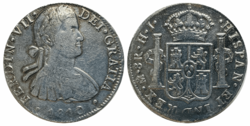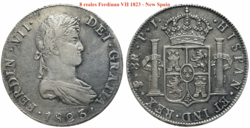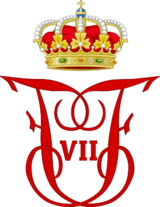Ferdinand VII facts for kids
Quick facts for kids Ferdinand VII |
|||||
|---|---|---|---|---|---|
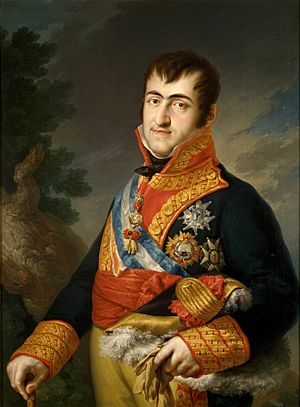
Portrait by Vicente López Portaña, around 1814–15
|
|||||
| King of Spain (more...) | |||||
| 1st reign | 19 March 1808 – 6 May 1808 | ||||
| Predecessor | Charles IV | ||||
| Successor | Joseph I or Napoleon I | ||||
| Prime ministers |
See list
Víctor Damián Sáez
(1823–1823) The Marquess of Casa Irujo (1823–1823) The Count of Ofalia (1823-1824) Francisco Cea Bermúdez (1824-1825) The Duke of the Infantado (1825-1826) Manuel González Salmón (1826-1832) The Count of la Alcudia (1833-1833) |
||||
| 2nd reign | 11 December 1813 – 29 September 1833 | ||||
| Predecessor | Joseph I | ||||
| Successor | Isabella II | ||||
| Born | 14 October 1784 El Escorial, Spain |
||||
| Died | 29 September 1833 (aged 48) Madrid, Spain |
||||
| Burial | El Escorial | ||||
| Spouse |
Maria Antonia of Naples and Sicily
(m. 1802; died 1806) |
||||
| Issue more... |
Isabella II Infanta Luisa Fernanda, Duchess of Montpensier |
||||
|
|||||
| House | Bourbon | ||||
| Father | Charles IV of Spain | ||||
| Mother | Maria Luisa of Parma | ||||
| Religion | Roman Catholicism | ||||
| Signature |  |
||||
Ferdinand VII (born October 14, 1784 – died September 29, 1833) was the King of Spain in the early 1800s. He ruled for a short time in 1808. Then, he ruled again from 1813 until he died in 1833. People called him el Deseado (the Desired) before 1813. After that, he was known as el Rey Felón (the Felon King).
Ferdinand was born in Madrid at El Escorial. He was the heir apparent to the Spanish throne. In 1808, he became king after a popular uprising. But Napoleon soon removed him from power. Ferdinand's rule brought big disagreements in Spain. Some people supported his traditional, absolute rule. Others wanted more liberal, modern ideas.
When he returned to power in 1813, he brought back absolute monarchy. This meant the king had all the power. He rejected the liberal constitution of 1812. In 1820, a revolt forced him to bring back the constitution for three years. This time was called the Trienio Liberal. In 1823, French forces helped him become an absolute ruler again. He also stopped newspapers that supported liberal ideas. Many writers were jailed.
During his reign, Spain lost almost all its lands in the Americas. These lands became independent countries. After he died, Spain entered a large civil war. Many historians see him as a king who was not very good at his job. They describe him as a ruler who was often unfair and didn't plan well for the future.
Contents
Early Life of King Ferdinand VII
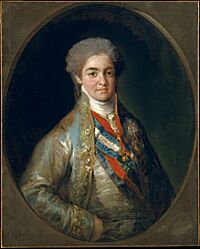
Ferdinand was the oldest son of Charles IV of Spain and Maria Luisa of Parma. He was born in the palace of El Escorial, near Madrid. When he was young, Ferdinand was the heir to the throne. But his parents and their main advisor, Manuel Godoy, kept him out of government.
People in Spain were unhappy with the government. This led to a rebellion in 1805. In October 1807, Ferdinand was arrested. He was involved in a plan to get help from the French Emperor Napoleon. This plan was called the El Escorial Conspiracy. When the plan was found out, Ferdinand apologized to his parents.
First Time as King and Giving Up the Throne
In March 1808, there was a big riot at Aranjuez. After this, King Charles IV gave up his throne. Ferdinand became king and asked Napoleon for support. But on May 6, 1808, Ferdinand also gave up his throne. Napoleon then kept Ferdinand guarded in France for six years. He stayed at the Château de Valençay.
Many Spanish government leaders accepted Ferdinand's decision. They also accepted Napoleon's brother, Joseph Bonaparte, as the new king of Spain. But the Spanish people did not agree. Uprisings started all over the country. This marked the start of the Peninsular War. Local groups called juntas were formed. They worked against the new French king.
After the Battle of Bailén, it was clear that the Spanish could fight back. So, the main Spanish council said that Ferdinand's abdication was not valid. On August 24, 1808, Ferdinand VII was again named King of Spain. The British government also recognized him as king in January 1809.
Second Time as King
Returning to Power
Five years later, Napoleon faced many problems. On December 11, 1813, he agreed to recognize Ferdinand VII as King of Spain. They signed the Treaty of Valençay. This allowed Ferdinand to return to Spain. Spanish people were happy to see him. They blamed those who supported France for the war.
Ferdinand soon found that Spain had changed a lot. During his absence, Spain had fought for its freedom. New ideas about government had grown. He was now expected to rule under the liberal Constitution of 1812. Before he could enter Spain, he had to promise to follow this constitution. But he only gave weak promises.
On March 24, French forces handed him over to the Spanish Army. As he traveled to Madrid, conservatives and church leaders encouraged him to reject the constitution. On May 4, he ordered the constitution to be cancelled. On May 10, he had the liberal leaders arrested. Ferdinand said the constitution was made without his permission. He also said it was made by a group that was not properly formed.
Ferdinand promised to call a traditional meeting of leaders. But he never did. He believed that all power belonged only to him, the king.
Meanwhile, wars for independence had started in the Americas. Many rebels were fighting for freedom from Spain. Spain's ships carrying money from its colonies were stopped. Spain became almost bankrupt.
Ferdinand's rule was very unstable. He changed his ministers very often. One writer said in 1814 that the king would arrest his own prime ministers. He seemed to act like a police agent and prison warden.
The king did show thanks to foreign powers who helped him. He made the Duke of Wellington, a British military leader, a member of a special Spanish order. This was the first time a Protestant was given this honor.
After the Mexican War of Independence, Mexico became independent. Mexican leaders wanted to offer the crown to Ferdinand VII. They hoped he would rule Mexico and Spain together. But Ferdinand refused to recognize Mexico's independence. He said no European prince could be Mexico's ruler. So, the crown went to a Mexican general instead.
Revolts and Challenges
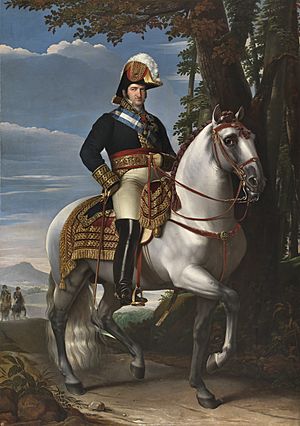
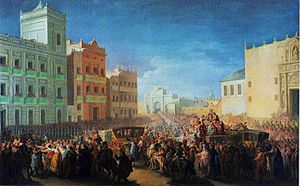
There were several military uprisings during Ferdinand's second reign. The first happened in September 1814. General Espoz y Mina led it in Pamplona. Another general, Juan Díaz Porlier, revolted in 1815. General Luis Lacy led an uprising in Barcelona in 1817. General Juan Van Halen did the same in Valencia in 1818.
In 1820, Rafael del Riego led the most successful uprising. This led to the Trienio Liberal, a three-year period of liberal rule. The king was quickly taken prisoner. Ferdinand had brought back the Jesuits when he returned. But now, liberals saw them as symbols of strict, absolute rule. Twenty-five Jesuits were killed in Madrid in 1822. For the rest of the 1800s, liberal governments often expelled Jesuits. Absolute governments brought them back.
In 1823, the French King Louis XVIII of France sent an army to Spain. This army helped Ferdinand regain his absolute power. In May 1823, the revolutionary group moved Ferdinand to Cádiz. He kept promising to change the constitution until he was free.
When Ferdinand was freed, he punished those who had opposed him. The French Duke who helped him even refused Spanish awards. This showed his disapproval of Ferdinand's harsh actions.
During his last years, Ferdinand's government became more stable. The last ten years of his reign are sometimes called the Ominous Decade. During this time, absolute rule was fully restored. Traditional university programs were brought back. Any opposition was stopped. This included both liberals and a group of reactionaries who revolted in 1827.
Death and the Succession Problem
In May 1830, Ferdinand VII issued a new law called the Pragmatic Sanction. This law allowed daughters to inherit the Spanish throne, not just sons. This rule had been approved in 1789 but was never officially announced. On October 10, 1830, Ferdinand's wife gave birth to a daughter, Isabella. She then became the next in line for the throne, ahead of her uncle, Carlos.
After Ferdinand died, Carlos revolted. He claimed he was the rightful king. Ferdinand's wife, Maria Christina, became regent for her young daughter. She needed support, so she turned to the liberals. She offered forgiveness to those who had been exiled. Liberals returned and played a big role in Spanish politics for many years. This led to the Carlist Wars.
Marriages and Children
Ferdinand VII married four times. His first three wives died.
- In 1802, he married his cousin, Princess Maria Antonia of Naples and Sicily. She was the daughter of Ferdinand I of the Two Sicilies. She had two pregnancies that did not result in live births. She died in 1806.
- In 1816, Ferdinand married his niece, Maria Isabel of Portugal. She was the daughter of his older sister. They had a daughter who lived only five months. They also had a stillborn daughter. Maria Isabel died in 1818 after the birth of her second child.
- On October 20, 1819, Ferdinand married Princess Maria Josepha Amalia of Saxony in Madrid. She was the daughter of Maximilian, Prince of Saxony. They did not have any children. She died in 1829.
- Lastly, on May 27, 1829, Ferdinand married another niece, Maria Christina of the Two Sicilies. She was the daughter of his younger sister. They had two daughters who survived. The older daughter, Isabella, became queen after Ferdinand died.
Issue
| Name | Birth | Death | Burial | Notes |
|---|---|---|---|---|
| By Maria Isabel of Portugal (1797–1818) | ||||
| Infanta María Luisa Isabel | 21 August 1817 Madrid |
9 January 1818 Madrid |
El Escorial | |
| Infanta María Luisa Isabel | 26 December 1818 Madrid |
El Escorial | Stillborn; Maria Isabel died as a result of her birth. | |
| By Maria Christina of the Two Sicilies (1806–1878) | ||||
| Infanta María Isabel Luisa | 10 October 1830 Madrid |
10 April 1904 Paris |
El Escorial | Princess of Asturias 1830–1833, Queen of Spain 1833–1868. Married Francis, Duke of Cádiz, had issue. |
| Infanta María Luisa Fernanda | 30 January 1832 Madrid |
2 February 1897 Seville |
El Escorial | Married Antoine, Duke of Montpensier, had issue. |
Honors and Awards
 Spain:
Spain:
- Knight of the Golden Fleece, October 14, 1784
- Grand Cross of the Order of Charles III, 1784
- Founder and Grand Master of the Military Order of St. Ferdinand, August 31, 1811
- Founder and Grand Master of the Military Order of St. Hermengild, November 28, 1814
- Founder and Grand Master of the Order of Isabella the Catholic, March 24, 1815
 Kingdom of Portugal: Grand Cross of the Sash of the Three Orders, 1796
Kingdom of Portugal: Grand Cross of the Sash of the Three Orders, 1796- France:
 French Empire: Grand Eagle of the Legion of Honour, 1806/07
French Empire: Grand Eagle of the Legion of Honour, 1806/07 Kingdom of France: Knight of the Holy Spirit, 1814
Kingdom of France: Knight of the Holy Spirit, 1814
 Kingdom of Prussia: Knight of the Black Eagle, June 3, 1814
Kingdom of Prussia: Knight of the Black Eagle, June 3, 1814 United Kingdom: Knight of the Garter, August 10, 1814
United Kingdom: Knight of the Garter, August 10, 1814 Russian Empire:
Russian Empire:
- Knight of St. Andrew, May 23, 1815
- Knight of St. Alexander Nevsky, May 23, 1815
 Denmark: Knight of the Elephant, August 29, 1818
Denmark: Knight of the Elephant, August 29, 1818 Austrian Empire: Grand Cross of St. Stephen, 1825
Austrian Empire: Grand Cross of St. Stephen, 1825 Two Sicilies:
Two Sicilies:
- Knight of St. Januarius
- Grand Cross of St. Ferdinand and Merit
Images for kids
See also
 In Spanish: Fernando VII de España para niños
In Spanish: Fernando VII de España para niños


